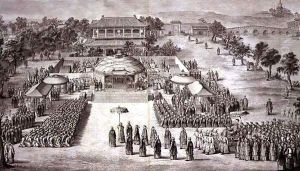Jean Denis Attiret Paintings
Jean Denis Attiret was a French Jesuit painter and missionary who played a significant role in the cultural exchange between the West and China during the 18th century. Born on July 31, 1702, in Dole, France, Attiret showed an early inclination towards art, which led him to study painting. He initially worked as an artist in Rome and later in France. However, his life took a significant turn when he decided to join the Society of Jesus, commonly known as the Jesuits, in 1727. As a Jesuit, he was sent on a mission to China in 1737 during the Qing dynasty, under Emperor Qianlong.
In China, Attiret adopted the Chinese name Wang Zhicheng and fully immersed himself in the local culture. He was one of several European Jesuits who were part of the Jesuit China missions, which aimed to spread Christianity and foster cultural exchanges. Attiret worked at the imperial court in Beijing and became a favorite painter of Emperor Qianlong. He was involved in creating artworks that combined European techniques with traditional Chinese artistic styles, which was part of a broader attempt by the Jesuits to blend Western and Eastern knowledge and customs.
Attiret's contributions to the artistic landscape of China during his time were significant. He painted portraits of the Emperor and other members of the royal family, as well as various subjects ranging from religious themes to botanical illustrations. One of his most notable projects was a series of engravings depicting the European-style palaces and pavilions in the Yuanming Yuan, the Old Summer Palace in Beijing, designed by fellow Jesuit artist Giuseppe Castiglione. These engravings were later published in Europe and contributed to the contemporary understanding of Chinese culture and aesthetics.
Jean Denis Attiret remained in China until his death on December 8, 1768. His work is remembered for its unique fusion of Western and Eastern artistic traditions, and he is considered an important figure in the history of cultural exchange between China and Europe. Although not as widely known as some of his contemporaries, Attiret's contributions to the arts and the Jesuit mission in China have earned him a place in the annals of art history.
